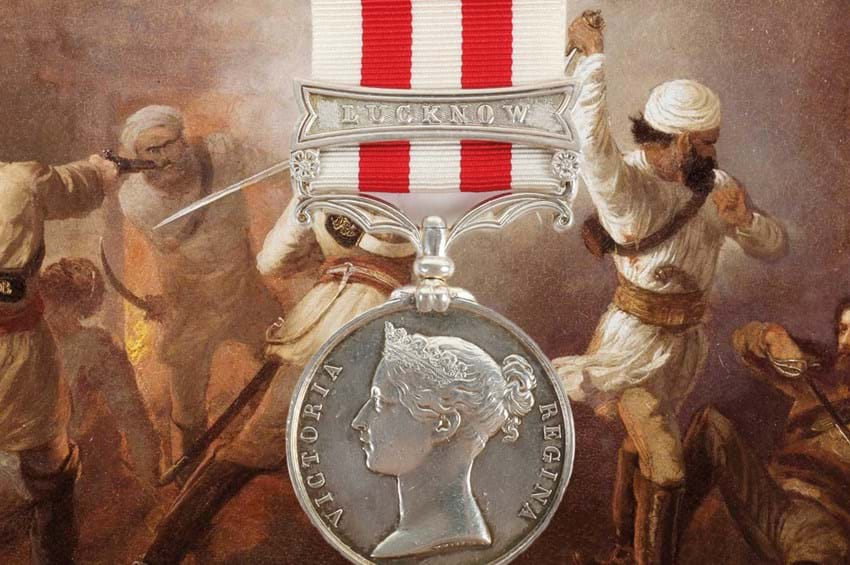The Indian Mutiny | Medals Up For Auction
17/10/2022 | Matthew Tredwen

We have a number of medals relating to the Indian Mutiny coming up in our next Fine Arms, Armour & Militaria Auction! Medals not only allow us to remember the major historical events which led to their issue, but also the experiences of the people involved in the circumstances at the time; in this case, the tumultuous relationship between the British & the native people of India during the mid 19th century. Read about the Indian Mutiny below, or follow the link at the bottom of the page to view the related medal lots now!
What was the Indian Mutiny?
The Indian Mutiny, also referred to as the Sepoy Mutiny (in India, often called the First War of Independence), was a large yet unsuccessful rebellion against British rule in India during 1857–59. It began in Meerut by Indian troops in the service of the British East India Company, but the rebellion quickly spread to Delhi, Agra, Kanpur & Lucknow.
What brought the Indian Mutiny about?
The glaring cause was, of course, British paramountcy — i.e. the belief in British dominance within Indian political, economic, and cultural life which had been introduced in India circa 1820. Increasingly, the British were using multiple tactics to seize control of the Hindu princely states. Swiftly, members of the Indian aristocracy were being replaced by British officials. A notable British technique of doing this was the 'doctrine of lapse', which prohibited a Hindu ruler from adopting a successor if they possessed no natural heir and, following their death or abdication, the annexation of their land. This was first carried out by Lord Dalhousie in the 1840s. To these problems, the growing discontent of the Brahmans may be added, many of whom had lost their lucrative positions and were being deprived of their revenues.
Another serious concern was the increasing pace of Westernisation in India - Hindu society was being affected by the introduction of Western ideas; Christian missionaries were challenging the religious beliefs of the Hindus and the introduction of Western methods of education were a direct challenge to orthodoxy, both Hindu and Muslim. In addition, the humanitarian movement led to reforms deeper than the mere political superstructure; Lord Dalhousie made efforts toward emancipating women and introducing a bill to remove all legal obstacles to the remarriage of Hindu widows.
The mutiny broke out in the Bengal army, the pretext for revolt being the introduction of the new Enfield rifle. To load it, the sepoys had to bite off the ends of lubricated cartridges. A rumour spread amongst the sepoys in the Bengal army that the grease used to lubricate the cartridges was a mixture of pig and cow lard; for the Muslims & Hindus to have oral contact with this substance was seen by them as an insult and religious slur. Despite there being no conclusive evidence that these materials were actually used on any of the cartridges in question, the idea that the cartridges were tainted in this way only added to their suspicion that the British were attempting to undermine Indian traditional society.
The British did not pay enough attention to the growing level of sepoy discontent and, thus, a rebellion arose.
The Mutiny Itself
A sepoy named Mangal Pandey played a key part in the events immediately preceding the outbreak. In late March 1857, Pandey attacked British officers at the military garrison in Barrackpore and following this attack was arrested and executed shortly after by the British in early April. Later that month, sepoy troopers at Meerut refused the Enfield cartridges, and were punished with long prison terms. This punishment enraged their comrades, who, on the 10th May, shot their British officers and marched to Delhi, where there were no European troops.
It was in Delhi that the the local sepoy garrison joined the Meerut men, and by nightfall the aged Mughal emperor Bahadur Shar II was nominally restored to power by this tumultuous soldiery. This seizure of Delhi created a focus for the sepoys and set a pattern for the whole mutiny which quickly spread throughout northern India.
The British attempts to suppress the mutiny were divided into three parts. First, came the desperate struggles at Delhi, Kanpur, and Lucknow during the summer; following that the operations around Lucknow in the winter of 1857–58, directed by Sir Colin Campbell. Finally came the “mopping up” campaigns of Sir Hugh Rose in early 1858. The mutineers commonly shot their British officers and were responsible for massacres at Delhi, Kanpur, and elsewhere including the murder or women and children which enraged the British. Some British officers also began to take severe measures before they knew any such murders had occurred and, in the end, the reprisals far outweighed the original excesses - though some officers did protest the severity of the bloodshed, hundreds of sepoys were bayoneted or fired from cannons in a frenzy of British vengeance.
Peace was finally officially declared on the 8th July, 1859.
The brutal results of this rebellion and the declaration of peace meant a diminishing in the hope of a revival of the past or an exclusion of the West for the Muslims & Hindus of India. India's traditional society had protested against the incoming alien influences, but had failed. The traditional structure of Indian society henceforth began to break down and was eventually superseded by a Westernised class system.
View the medals related to this conflict in the catalogue of our upcoming auction!

